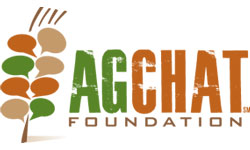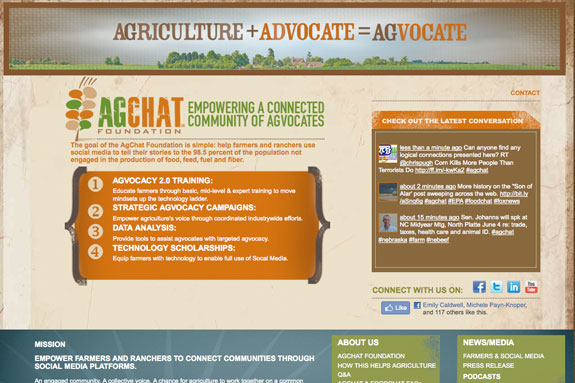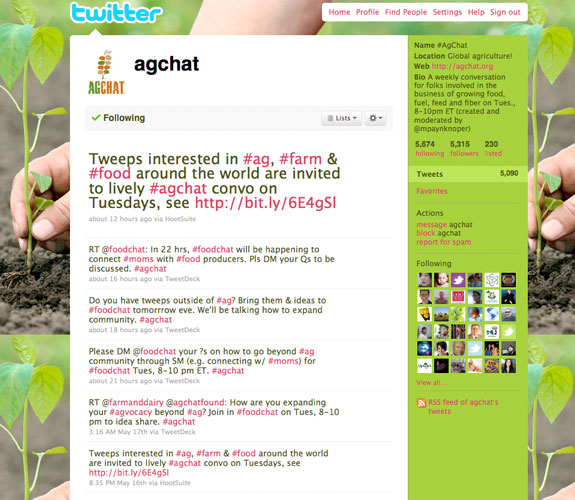A board of agriculture industry leaders recently launched the AgChat Foundation, an organization centered around helping farmers use social media to tell their story. Michele Payn-Knoper, a professional ag speaker who founded the #agchat community on Twitter, and Kathy Swift, a dairy veterinarian from Florida on the Board of Directors, discussed the goals of the foundation with Web Editor Emily Caldwell.
Q. How did #agchat grow from a Twitter community into the AgChat Foundation?
Payn-Knoper: There were several farmers, all of whom are now actual officers of the foundation, who had been developing ideas around how agriculture can use social media. The AgChat Foundation is more or less an umbrella organization of ideas.
It’s led by farmers to serve farmers, and it’s truly designed to empower more communities around “agvocacy” within agriculture and outside of agriculture. We really believe the foundation is more powerful than a singular tool like Twitter or one person’s idea. It’s about being able to grow a community to speak out proactively for agriculture. And #agchat has proven itself to be a gathering place for people in agriculture to build community and business collaboration and to have tough discussions about a wide range of issues.
Q. As a non-profit organization, how is the AgChat Foundation being funded?
Payn-Knoper: We are a registered Indiana not-for-profit organization and are seeking 501(c)(3) status. We will have corporate sponsors from across all sectors of agriculture, including some nontraditional organizations, such as the fresh produce and organic people. We’ve had a lot of interest expressed from individuals for making contributions. By the time this article goes to print, we should have the contributions option available on the website, http://agchat.org, accepting contributions through Pay Pal.
Swift: Large corporations or entities obviously can donate larger dollar amounts, but that doesn’t mean that we don’t appreciate the grassroots, local farmer level. Certainly $5 or $10 donations will be welcome.
Q. Why were each of you personally invested in being a part of the Foundation?
Swift: Ever since I've been a veterinarian, I've been talking to farmers about how important it is that we get their story out to consumers, especially as the media portrays agriculture and farming sometimes in not such a pretty light. I try to explain to them how important it is that they need to educate people, and they just kind of had their heads a little buried in the sand about it, to my disappointment. For the longest time, I felt like I was the only one out there going, "Hey! Come on! We have to get on this bandwagon." So it was great to get involved with the #agchat community and realize there are other people out there who feel the way I do. And when the opportunity came to really move forward and get our message out there, it was a no-brainer for me. I'm 100 percent in the project.
Payn-Knoper: And I think you would find that to be true for most people that are engaged in the foundation. They're very passionate about trying to use social media to tell agriculture's story and to try to affect change. Personally, my life's mission -- my work as a professional speaker -- centers around making closer connections from the farmgate to the consumer plate. That has been the driving force from why I started the #agchat discussion initially to the AgChat Foundation.
Q. Tell me more about the vision for the Foundation’s Technology Scholarships?
Swift: We want to help farmers get the technology in their hands to help promote their message. It can be a little difficult for someone to get started, whether they just don’t have the knowledge or the funds to get started. We want to hear someone’s vision or hear a project they’d like to accomplish. And then we’ll review applications and help fund the projects that we anticipate will have the most impact on consumer knowledge and consumer purchases.
Payn-Knoper: And it can be as simple in some cases as putting a Flip video cam in a farmer’s hands so they can walk out and give people a virtual tour of their operation. It may be putting a wireless tower up on a farm that can’t get a wireless signal because of trees. Scholarships can be offered in designated geographical areas or in industry sectors, according to sponsors’ interests. Other sponsors will be interested in allocating funds across North America or contributing to the big picture of the foundation.
Q. What are your plans for Agvocay 2.0 Training, Strategic Agvocacy Campaigns and Data Analysis?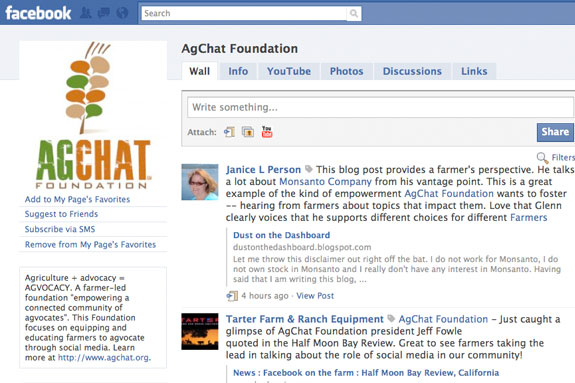
Payn-Knoper: The Agvocacy 2.0 Training is designed to encompass webinars for basic social media level users and mid-level training conferences for people who are already using social media but need more advanced tools. Our goal is a conference for 40 or 50 people late this summer to really be able to help them tap into social media tools as agvocates. That also brings in the third element, which will be advanced level mastermind training for folks that have been part of social media for some time and would like to share ideas. Those are the same type of people that will be presenting at the conference, giving them the opportunity to collaborate and knock around different ideas.
Swift: The important part about the training is that a lot of people are hearing about Facebook and Twitter and blogs, but they just don’t know what to do next. I think the training will really help bring it to their level. And obviously if you have other farm and ag folks presenting it to them, then we can help put it into terms that makes it easier for everyone to understand.
Payn-Knoper: The Strategic Agvocacy Campaign is really about trying to look at different opportunities to tell agriculture’s story in a positive way. For example, the #thankafarmer campaign the day before Thanksgiving last year was an effort that was coordinated by several different farmers, agribusiness professionals and organizations from across the industry working behind the scenes. It generated more than 6.7 million unique impressions in a 24-hour period.
Swift: We also evaluate current events before these strategic campaigns. The #oink campaign came about because of the H1N1 virus and people calling it swine flu. We were trying to encourage people to call it H1N1 because it didn’t have anything to do with pigs and pork was safe to eat. We react accordingly to events like that so we can try to educate the public with a good campaign.
Payn-Knoper: The fourth program is Data Analysis. We have some incredible skill sets that are on the board team; farmers who love technology and have learned to use data in amazing ways. It’s about being able to analyze the data that can be gathered from Twitter and Facebook so that it can be used to measure and monitor agvocacy efforts. For example, us being able to tell you that we had 6.7 million unique impressions on #thankafarmer is because of farmer efforts to be able to capture those measurements.
Q. Have you seen a particular sector of agriculture emerge as leaders of social media?
Swift: Not necessarily. When it comes to #agchat and #foodchat, there are certain sectors with the industry that perhaps are more represented than others based on the topic of that evening. But I would say overall, everything is pretty well represented. Maybe I’d like to see more from the fuel and fiber folks. But within the animal production industry – both beef and dairy – there seems to be pretty good representation.
Payn-Knoper: I might be a little biased, and I’ve been asked that question a lot, but I think dairy is probably up there. Training for dairy producers started earlier, and dairy has done a good job of telling our message. So I’ve seen them get involved early and therefore there’s more of them on now. I always think there’s room for improvement, though.
Q. Since launching the foundation, what would you say has been its most significant accomplishment?
Swift: Once we launched the website and the official notification of the AgChat Foundation, I felt like it went to the next level. People come and participate now, knowing that this is more than just a weekly chat on Twitter. There’s actually a group now that is going to help promote agriculture at many different levels.
Payn-Knoper: Rather than waiting to react to HSUS and PETA misinformation, we are tapping into a tool that will allow us to proactively build connections between the farm gate and consumer plate. Social media allows everyone to grow a new and different network to tell the dairy story; you’d be amazed how a Facebook update about your work or a Twitter conversation can mitigate an activist’s claims.
Professionally, this foundation has probably been the most significant effort that I’ve been involved with because of the group of people working on it. I really believe that agriculture has an opportunity to do this right and finally work together. We all agree that we need to be good stewards of animals and of the land. That’s not size-based, that’s not sector-based, that’s not politics-based. That’s just what we all believe in, so it’s time to tap into that commonality.
Q. Why is social media so important in bridging the connection from farmer to consumer?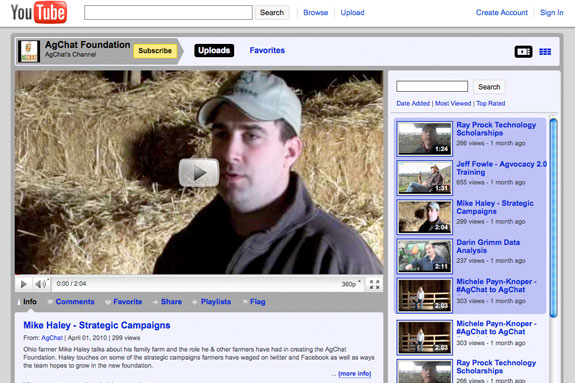
Payn-Knoper: For me, it boils down to numbers: 450 million users on Facebook and 50 million tweets a day. There's no question whatsoever that any dairy producer reading your magazine -- unless they live in a place that I don't know about -- has no opportunity to connect with those kinds of people. Social media gives a voice to agriculture that we as 1.5 percent of the population has had a very hard time finding. We have to take responsibility for people not knowing where their food comes from because a portion of it is our fault. We historically have not spoken out. Now we have the opportunity to share something that's considered a novelty to most of the population. And you can do it in less than 15 minutes a day. That's the beauty of it.
Swift: I'd also like to mention that all of these people that I've met through the agchat and foodchat conversations, 95 percent of them are people I did not know before we started this.
Payn-Knoper: And it's amazing, isn't it?!
Swift: It is. And now, it's like we're all best buddies. It's great that we can all come together now, and certainly we're looking to add more to our happy family.
Payn-Knoper: Yes, and that's one sense of community. The other sense of community is this. The longer this has gone on, the more I hear people saying, "Well, are we preaching to the choir or are we preaching to the choir?" My definitive answer to that is absolutely not. If you build your community right and you continue to expand your community, then it's not just about connecting with agriculture folks. It's a wonderful opportunity to share all sorts of technical information. But if we're going our job well and using social media the right way, then it goes well beyond our traditional farm community.
Q. What do you want people to fully understand about the AgChat Foundation?
Payn-Knoper: We want farmers to understand this is for them and it's led by farmers. It's not anyone doing anything from a corporate standpoint. It's truly meant to be a grassroots effort.
Swift: And we certainly welcome anyone and everyone who wants to be involved with this organization, so not just farmers. Speaking as a member of the veterinary community, I try to encourage everyone I come in contact with to also be a part of this organization and to invite others. PD
Get involved:
- Visit the AgChat Foundation website at http://agchat.org
- Follow #agchat on Twitter (www.twitter.com/agchat) or on Facebook (www.facebook.com/AgChatFoundation)
- Connect with Michele Payn-Knoper (www.twitter.com/mpaynknoper) and Kathy Swift (www.twitter.com/cowartandmore)
- Learn more about ag and social media at http://causematters.wordpress.com/ag-social-media/
